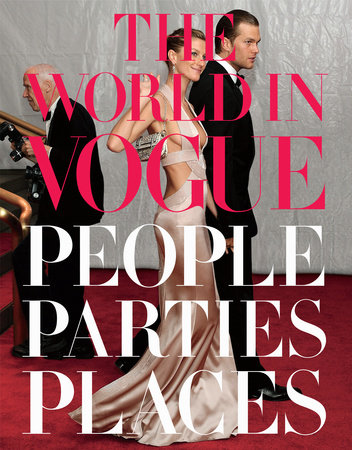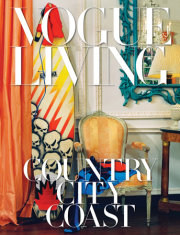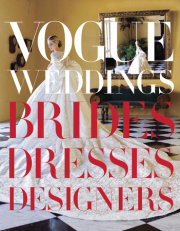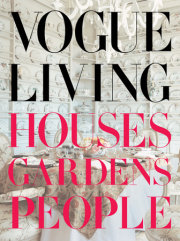In the teeming century that has passed since Condé Nast acquired
Vogue in 1909, the magazine has held a mirror to its times, reflecting a nexus of beauty, talent, and glamour through the decades.
In the mistiness of the Baron Adolphe de Meyer’s images, the glacial perfection of Edward Steichen’s, or the acuity of Irving Penn’s; against the fanciful backdrops of Cecil Beaton’s elaborate studio sets or the cool emptiness of Richard Avedon’s; under the elegant gaze of Horst P.
Horst and George Hoyningen-Huene and Henry Clarke or the mischievous one of Helmut Newton; in the glamorizing visions of Steven Meisel and Herb Ritts and Mario Testino or via the all-seeing eye of Annie Leibovitz; and in the torrent of words from John McMullin, Truman Capote, Lesley Blanch, Valentine Lawford, Francis Wyndham, Plum Sykes, Joan Juliet Buck, André Leon Talley, and William Norwich, the chameleon worlds of fashion, society, and Hollywood have been memorialized by
Vogue with wit and reverence. Tradition and innovation, fastidiousness and carefree nonchalance, have each been embodied at various turns by the men and women who made fashion, and
Vogue has captured them all, celebrating their style and their surroundings, their parties and their philanthropy.
Two world wars and the Great Depression seismically shook the ordered societal hierarchies that a century ago seemed inviolate. But in their stead came new freedoms and liberations, and
Vogue has been there to record the triumph of the unfettered imagination. The world as
Vogue began to document it between the wars—where beauty and talent were as potent as title and pedigree—was in no small measure the literal creation of the urbane and cultivated Condé Nast himself. “What Chanel did to free fashion from elaborate stuffiness, Condé Nast did for society,” wrote his protégée Carmel Snow. In 1925, when Condé Nast gave the first of his legendary parties in his Park Avenue penthouse (lavishly decorated by Elsie de Wolfe), Snow noted, “he couldn’t leave out his friend Mrs. Vanderbilt and he couldn’t leave out his friend George Gershwin so he had them both—and thus café society was born.”
As this book reveals, the social mix of people drawn from the fields of the arts, culture, fashion, “society,” philanthropy, and politics continues to inform
Vogue’s sensibility—both in the stories and portraits in the magazine’s pages and in its glamorous satellite events, including the Metropolitan Museum’s annual Costume Institute gala.
The social order of the magazine’s earliest years, from its founding in 1892, was vividly evoked in a series of stories that appeared through the 1930s and 1940s, written by Frank Crowninshield, the Boston Brahmin editor of
Vanity Fair (1914–1936) and subsequent Fine Arts Editor of
Vogue. Crowninshield conjured the New York of Edith Wharton, when society, as he recalled, was ruled by “the imperial and really all-powerful Mrs. William Astor,” its numbers strictly prescribed by the capacity of her ballroom (400 people).
A mazurka, a white dress by Doucet, a whispered colloquy in a conservatory, the cut-crystal candelabra, the scent of orris on women’s gloves and of Guerlain’s lavender on their bodices and hair, the tap of a Venetian fan, a Hungarian band in wine-coloured jackets . . . flunkies in braided liveries, Strauss’s Lorelei Waltz, the sound of light laughter, a hand pressed on the stairway, white
violets, gold favors, black ostrich feathers, the gas-lights of Fifth Avenue, sleigh bells, and drifts of white snow—a debutante dance, as I remember it, 50 long years ago.
Money, beauty, and ambition might have been inadequate to penetrate the bastion of Mrs. Astor’s ballroom, but the scions of the impoverished noble families of Europe were less impervious to these qualities. Flocks of so-called dollar princesses formed matrimonial liaisons with the illustrious houses of England and France, of Spain, Portugal, and Italy, and
Vogue was there to celebrate them. In 1895, the exquisite Consuelo Vanderbilt led the way, compelled into a loveless match with the sadistic ninth Duke of Marlborough.
Vogue secured exclusive coverage of Consuelo’s trousseau, including details of her wedding dress, made under the supervision of the famed society dressmaker Mme Donovan and rumored to have cost nearly $7,000, and even her lingerie and corsets. (The alliance of beauty and power remains an enduringly potent one:
Vogue put the Slovenian beauty
Melania Knauss on its February 2005 cover in the $200,000 Dior Haute Couture wedding gown that John Galliano designed for her wedding to Donald Trump—a dress so opulent and voluptuous it might have been fashioned for an Edwardian belle.)
After World War I, the magazine chronicled a universe in Europe where looks, flair, and brilliance were passports to a new fluid
social order that thrived on novelty and amusement. It was this brave new world that Condé Nast would bring to America and that would shape
Vogue’s worldview for the rest of the century and beyond. “New York has been small, conservative, shall we
say provincial,” wrote
Vogue in 1930, “and only lately has she been able to mix society (exactly what does that word mean?) and the professional classes—artists, writers, actors, musicians, and playwrights—without the danger of boring both sets.”
Parisian society, meanwhile, was in the vanguard of the social experiment that Condé Nast championed on the other side of the Atlantic. In France, the balletomane Comte Étienne de Beaumont and the visionary art patron the Vicomtesse Marie-Laure de Noailles were preeminent figures in the seamless mixing of aristocracy and the arts. At the de Noailleses’ palatial town house on the Place des États-Unis, guests were entertained by everyone from Bricktop to Georges Auric, and Europe’s aristocrats mingled with the city’s most distinguished and exciting cultural figures—Breton, Sartre, Aragon, Picas so, Braque, Chagall, Klee, Stravinsky among them.
At the de Beaumonts’ annual costumed Bal des Entrées, the highest French society mingled with haute bohemia, making their entrances in imaginatively costumed and carefully choreographed groups (Lady Abdy had Balanchine arrange hers). At the Bal Chinois at the Opéra (1923), for instance, the couturier Paul Poiret held court as a Chinese dignitary, and the Comtesse de Beaumont joined the Marquise de Polignac and the beautiful Duchesse de Gramont (whose fashion choices
Vogue scrupulously documented) for the “pageant of Chinese crystals,” wearing sensational costumes of silver cloth specially created by Vionnet and
Chéruit. Another enterprising group “were costumed as the hideous maladies feared by the Empress of China—bubonic plague, cholera morbus, spotted typhus, and boils.”
American socialites were quick to imitate, although a true original was the gargantuan pleasure-seeker Elsa Maxwell, from Keokuk, Iowa, who set the bar for entertaining in the modern manner. “Ruthlessness is the first attribute toward the achievement of a perfect party . . . ,” Maxwell explained in 1930. “Guests should be selected with as much care as a new Reboux hat. . . .” Maxwell’s guest lists also reflected the new social order. At a party at the Paris Ritz in honor of George Gershwin (1928), for instance, “the Cole Porters, the Duchess of Sutherland, Prince and Princess Serge Obolensky, Baron and Baroness Eugène de Rothschild, Michael Arlen, the Grand Duchess Marie, Princess Ilyinsky, Sir Charles Mendl, Allie Mackintosh, and Miss Fellowes-Gordon came. . . . After dinner, Gershwin and Cole Porter . . . vied with each other in playing and singing till the early hours of a clear Paris dawn.”
If Maxwell was party planner extraordinaire, the period’s social chronicler was the diminutive John McMullin. In the 1920s, he had re-created Walter Robinson’s As Seen by Him rubric, from the turn of the century. For two decades McMullin reported the fashions and foibles of the day, as well as on the playgrounds—Saint-Moritz, Cannes, Le Touquet, Deauville, Biarritz, Venice, and Monte
Carlo—made newly fashionable by Maxwell herself.
From the beginning,
Vogue’s vision of fashion was shaped by It girls, drawn not merely from the sequestered ranks of society but from the realm of entertainment, too. By dint of their beauty, presence, and innate style, these women—socialites, performers, models—set the fashions of the day.
In the teens, it was the willowy, bob-haired ballroom dancer Irene Castle who transformed the way women wanted to look, banishing the full-bosomed Edwardian Gibson Girl ideal. In the nineties it was Kate Moss, the waif from Croydon, who emerged to challenge the Amazonian magnificence of the reigning supermodels.
Baron de Meyer,
Vogue’s star photographer from the teens and the early twenties, found his perfect subjects in movie stars Mary Pickford and the sisters Lillian and Dorothy Gish. Onstage, Ina Claire did much to launch Chanel in twenties New York, eclipsing the former power of the socialite tastemakers, while Gertrude Lawrence embodied Molyneux’s elegance in Noël Coward’s plays and revues—and popularized the Antibes suntan.
Vogue heralded Katharine Hepburn as “cinema’s latest meteor” in 1933, and Joan
Crawford, wearing Schiaparelli’s extreme new broad-shoulder line, assumed “her most ambiguous look” for Steichen (1932). Meanwhile, the exaggerated glamour of Marlene Dietrich and Greta Garbo transformed the beauty industry
in the thirties and inspired
Vogue’s fashion photographers, artists, and society ladies to new heights of artifi ciality.
The concept of a professional supermodel was first embodied by the fabled Dolores (née Kathleen Mary Rose), a statuesque six-foot-tall blonde who had been discovered by the visionary dressmaker Lucile (Lady Duff Gordon) in 1909. Florenz Ziegfeld spotted Dolores in a Lucile fashion show and put her in his
Follies dressed as a white peacock. Throughout the decades other celebrity models have created lives and careers beyond the pages of
Vogue.
Copyright © 2009 by Hamish Bowles. All rights reserved. No part of this excerpt may be reproduced or reprinted without permission in writing from the publisher.










